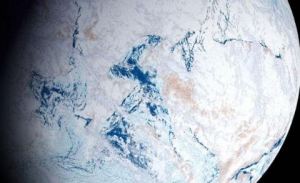The earth’s climate is anything but regular, with every year a repeat of the last. The White Earth Effect is the realization of what would happen if the earth was entirely covered in snow and ice. The bottom line is that the Earth would then reflect the sunlight rather than absorb it, and hence, the planet would never again move back to a warm climate – global freezing. The critical understanding of the cyclical nature of our environment has been hampered by people trying to further personal agendas distorting real trends in our climate. The nonsense about global warming has done far more damage than most people realize to our understanding cycle for it is the same crisis we have with Marxist-Keynesianism – the assumption that man can control his surroundings and society.
Global Warming has propagated false ideas about the world we live in. It has claimed that man is even capable of altering the climate, covering up the fact that it is a dynamic cyclical system that we are not bothering to understand. This is as bad as assuming the Earth is flat, for back then, the disbelievers argued that it would be absurd, for nobody could stand on a ball upside down.
It would be nice just for once if people stopped grabbing bits of information and attributing that as proof of what is really a political movement for a hidden agenda. The Earth is no more in a Global Warming trend caused by man than Elvis is still alive and on stage in Vegas.
The White Earth Effect describes a theory that for millions of years the Earth was almost entirely smothered in ice, stretching from the poles to the tropics. This freezing happened over 650 million years ago in the pre-Cambrian period, though it’s now thought that there may have been more than one of these global glaciations. They varied in duration and extent, but during a full-on snowball event covering the entire planet, life could only cling on in ice-free refuges or where sunlight managed to penetrate through the ice to allow photosynthesis. As long as there were some spots that could absorb sunlight, then the cycle would be capable of a reversal back to a warming climate.
The climate has always been a dynamic system that oscillates between extreme cold and extreme heat. Perhaps you recall the term Ice Age? Even the Sun is a thermodynamic system that oscillates in a cycle of about 300 years between maximum and minimum energy output with a fluctuation range of about 15%. Climatologists have universally agreed that the long-term behavior of our planet’s oceans and atmosphere could at any point in time shift without reason (beyond a chaotic shift) from one that is very inhabitable to an icy tomb of doom from which there is no return.
The Father of Chaos Theory is Edward Norton Lorenz (1917–2008), an American mathematician and meteorologist. Lorenz was certainly THE pioneer in Chaos Theory. A professor at MIT, Lorenz was the first to recognize what is now called chaotic behavior in the mathematical modeling of weather systems.
During the 1950s, Lorenz observed that there was a cyclical, non-linear nature to weather, yet the field relied upon linear statistical models in meteorology to do weather forecasting. It was like trying to measure the circumference of a circle with a straight-edge ruler. His work on the topic culminated in the publication of his 1963 paper Deterministic Non-periodic Flow in the Journal of the Atmospheric Sciences and with it, the foundation of chaos theory. During the early 1960s, Lorenz had access to early computers. He was running what he thought would be random numbers and began to observe there was a duality of a hidden repetitive nature. He graphed the numbers that were derived from his study of convection rolls in the atmosphere. What emerged has been perhaps one of the most important discoveries in modern time.
This illustration of the Lorenz Strange Attractor is incredibly important and was first reported in 1963. Lorenz’s discovery of a strange attractor was made during an effort to create a model of weather patterns. The actual experiment was an attempt to model the atmospheric dynamics of the planet. It involved a truncated model of the Navier-Stokes equations. It is a visual example of a non-linear dynamic system corresponding to the long-term behavior in a cyclical manner, revealing a hidden order we cannot otherwise observe.
Lorenz also discovered in 1969 that very minor differences in a dynamic nonlinear system could trigger vast and often unsuspected drastic results. These observations ultimately led him to formulate what became known as the term Butterfly Effect in 1969 regarding this fascinating discovery. Very tiny changes in what might appear to be minor data at the outset had a ripple effect throughout the entire system, creating substantially different outcomes. This term grew out of an academic paper he presented in 1972 entitled: “Predictability: Does the Flap of a Butterfly’s Wings in Brazil Set off a Tornado in Texas?”
From a dynamic system perspective, such a possibility that the earth could go to one extreme, such as the White Earth Effect, and fail to recover is not really just a matter of chance that could emerge out of nowhere. It was Lorenz who stated that it would take some “huge kick” of energy to upset the balance of our climate to such a degree. Lorenz called this system “almost-intransitivity.”
The White Earth Effect is what would happen if the climate moved cyclically to the extreme on the cold side. The Earth has, for millions of years, almost been entirely covered in ice, stretching from the poles to the tropics. The failure to cover every spot was our saving grace. If there was no such ice-free zone, the cycle would stop as the ice would reflect the sunlight, the planet would stay cold, and life would be extinguished – the White Earth Effect.












